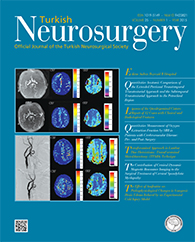2Peking University First Hospital, Department of Radiology, Beijing, China
3Peking University First Hospital, Department of Neurosurgery, Beijing, China
4Beijing Tiantan Hospital, Department of Emergency Interventional Neuroradiology, Beijing, China DOI : 10.5137/1019-5149.JTN.8987-13.1 AIM: We aimed to evaluate cerebral hemodynamic status of preoperative and postoperative revascularization treatment by oxygen extraction fraction (OEF)-magnetic resonance imaging (MRI) in patients with severe cerebrovascular stenosis or occlusive disease.
MATERIAL and METHODS: This study enrolled 9 symptomatic patients with severe cerebrovascular disease and 9 age-matched normal volunteers. Cerebral blood flow (CBF) and OEF were determined in all subjects by functional MRI. Brain regions with elevated OEF above normal range were defined in the patients preoperatively. The values of pre- and postoperative OEF in these regions were compared.
RESULTS: A total of 16 regions of interest (ROIs) had elevated OEF before the vascular surgery, with relative CBF (rCBF) values ranging from 0.2 to 1.0. OEF decreased to normal range in 15 ROIs postoperatively, which indicated hemodynamic improvement in these regions. The OEF value of the high-OEF group (preoperative OEF value ranged from 0.365 to 0.400) had a significant decrease compared with those of the low-OEF group (preoperative OEF value ranged from 0.350 to 0.365), which showed an a statistical difference (p = 0.001).
CONCLUSION: OEF was elevated in patients with severe ischemic cerebrovascular disease, and decreased after successful revascularization. OEFMRI can provide quantitative information for evaluating the hemodynamic status and selecting the candidates suitable for revascularization.
Keywords : Oxygen extraction fraction (OEF), Cerebral blood flow (CBF), Magnetic resonance imaging (MRI), Stent, Superficial temporal artery-middle cerebral artery (STA-MCA), Bypass




